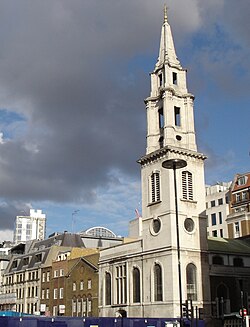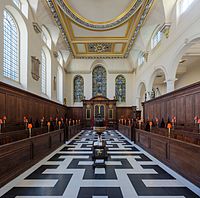St Vedast Foster Lane
| St Vedast Foster Lane | |
|
London, Middlesex | |
|---|---|
 Photo of St. Vedast Foster Lane | |
| Church of England | |
| Diocese of London | |
| Location | |
| Location: | 51°30’54"N, 0°5’46"W |
| Address: | Foster Lane |
| History | |
| Baroque | |
| Information | |
St Vedast Foster Lane or Saint Vedast-alias-Foster is a church in Foster Lane in the City of London. The street name, 'Foster' is an Anglicisation of the name "Vaast", as the saint is known in Europe[1]: Vedast was French saint whose cult arrived in Britain through contacts with Augustinian clergy.
History
The original church of St Vedast was founded before 1308 and was extensively repaired by 1662 on parochial initiative.[2]
Although the church was not completely destroyed in the Great Fire of London of 1666,[3] the church required substantial reconstruction by the office of Sir Christopher Wren between 1695 and 1701,[4] with some parts of the mediæval fabric incorporated,[3] most noticeably the south wall which were revealed by restoration in 1992–3 and possibly the lower stages of the tower. The three-tier spire, considered one of the most baroque of all the City spires, was added in 1709–12[5] at a cost of £2958, possibly to the designs of Nicholas Hawksmoor, whose correspondence with the churchwardens survives, but drawings for which do not. The organ was built by Renatus Harris in 1731, originally for St Bartholomew-by-the-Exchange.
Wren's church was gutted a second time by firebombs during the London Blitz[6] of 1940 and 1941.[7] A proposal by Sir Hugh Casson to leave this and several other churches as roofless ruins to serve as a war memorial was not implemented. The post-war restoration within the old walls and re-roofing was undertaken by Stephen Dykes Bower. He re-ordered the interior in a collegiate chapel style with seating down each side with a side chapel in the former South aisle, and squared the old walls which were not rectangular in plan so that the altar now faces the nave squarely. He made an almost imperceptible taper in the pews and floor pattern, to give a false perspective towards the altar, making the church look longer than it is. Dykes Bower designed the fine plaster ceiling, in the style of the late seventeenth century, which is embellished with gold and varnished aluminium leaf. Fittings from other destroyed City churches, including the richly carved pulpit from All Hallows Bread Street and the font and cover from St Anne and St Agnes were incorporated into the new design. Dykes Bower commissioned the Whitefriars glass windows in the East End, showing scenes from the life of St Vedast. These windows use opaque glass to hide tall buildings behind and to disguise the fact that the East wall is a wedge in plan. The work was completed in 1962. An aumbry above the south chapel altar is by Bernard Merry and the organ is 1955 by Noel Mander, in the re-used 1731 Renatus Harris case.
Dykes Bower also built a small Parish Room to the North East of the church in 17th-century style and a Georgian-style rectory, adjacent to the church, on Foster Lane in 1959 – in the first floor room of which is an important mural by Hans Feibusch on the subject of Jacob and the Angel. A niche in the internal courtyard of the building contains a carved stone head by sculptor Jacob Epstein.[8]
The church is noted for its small but lively baroque steeple, its small secluded courtyard, stained glass, and a richly decorated ceiling. It also has a set of six bells, cast in 1960, that are widely regarded as being the finest sounding six in London.[9]
The church is a Grade I listed building.[10] The rectory is listed as a Grade II building too.
Outside links
| ("Wikimedia Commons" has material about St Vedast Foster Lane) |
- St Vedast-alias-Foster from Friends of the City Churches
- 360° panorama inside St Vedast-alias-Foster
References
- ↑ Wheatley, Henry Benjamin: '[url=https://books.google.com/books?id=hz0OAAAAIAAJ Literary Blunders: A Chapter in the "History of Human Error]' (E Stock, 1893) pages 13–15
- ↑ "The Churches of the City of London" Herbert Reynolds 2008 ISBN 1-4097-1376-8
- ↑ 3.0 3.1 "The Visitors Guide to the City of London Churches" Tucker, T: London, Friends of the City Churches, 2006 ISBN 0-9553945-0-3
- ↑ "The City Churches" Tabor, M. p105:London; The Swarthmore Press Ltd; 1917
- ↑ "London:the City Churches” Pevsner, N/Bradley, S New Haven, Yale, 1998 ISBN 978-0-300-09655-2
- ↑ "The London Encyclopaedia" Hibbert, C; Weinreb, D; Keay, J: London, Pan Macmillan, 1983 (rev 1993,2008) ISBN 978-1-4050-4924-5
- ↑ "The Old Churches of London" Cobb, G: London, Batsford, 1942
- ↑ National Heritage List 1375660: St Vedast Foster Lane
- ↑ Church Bells of the City of London
- ↑ National Heritage List 1064666: St Vedast


